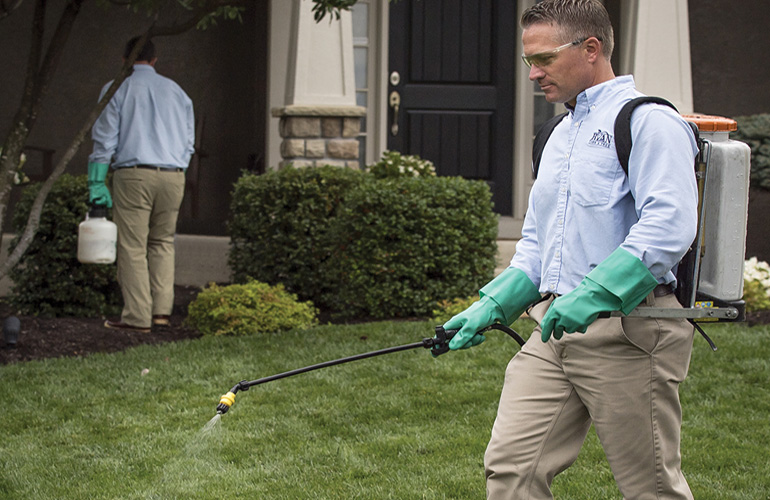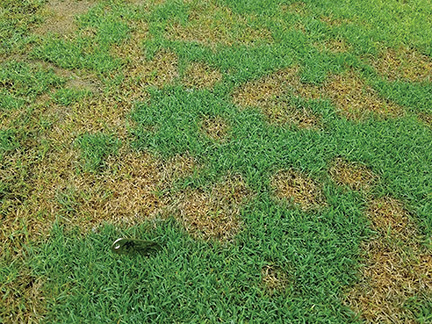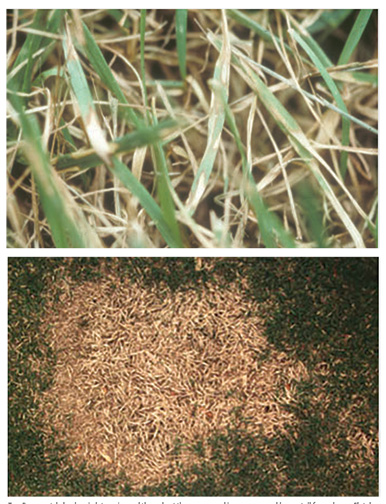Summer is in full swing, and once again professional lawn care operators are faced with a familiar foe—turf disease. From June through August, cool-season grasses are more commonly affected by disease than warm-season grasses—which tend to experience more disease pressure in the spring and fall.
Though it’s difficult to predict exactly which diseases will be more widespread in any given year, if you are growing perennial ryegrass and tall fescue, you’ll likely see your share of Pythium blight, brown patch, and gray leaf spot this summer. If your landscape business is located where turfgrasses like bermudagrass are prevalent, spring dead spot will be a common malady come next spring.

Maintaining sound cultural practices such as fertilization, pruning trees and shrubs, aeration, and proper mowing techniques are only part of the equation in creating and maintaining healthy turf. Fending off disease and keeping customers happy requires an understanding of the link between how ever-changing environmental conditions promote specific diseases in your region.
Turfgrass diseases appear when specific environmental conditions occur in conjunction with a continual attack by a pathogen on a susceptible host plant. In plant pathology, these three requirements—host, pathogen, and environment—make up what is termed the “disease triangle.” The longer the amount of time the three legs of the triangle are present, the greater potential for the pathogen to perpetuate and spread disease.
The best way to prevent and control turfgrass disease is to interrupt this disease triangle. In order to appropriately disrupt this interaction, it is important to understand: the biology of the pathogens which cause disease; the process by which the host plant gets infected; and what specific environmental conditions to look for when plotting out a treatment program for your customers.
Disease Overview
Some of the most common turfgrass diseases you may encounter this summer and fall include:
Pythium Blight. Pythium blight can cause significant damage to nearly all turfgrass species, but it’s common in cool-season turfgrasses such as perennial ryegrass, annual bluegrass, and Kentucky bluegrass. Caused by an oomycete, a fungal-like pathogen, Pythium blight requires a specific set of environmental conditions to develop, such as continuous leaf moisture for 14 consecutive hours and temperatures above 85°F during the day and above 65°F at night.

Symptoms of the disease start as small pockets of dark-colored, water-soaked turf that have a “greasy” feel. Affected turf quickly becomes bronze or tan in color and usually follow the path of water movement. Significant amounts of cottony aerial mycelium are a characteristic sign of the disease, which is often followed by rapid death (blighting) of turf.
Monitoring for the environmental conditions above is key to deploying effective preventive measures to control the disease. When warm days and warm nights are forecast, promote air movement by pruning shrubs and trees, avoid overfertilization (which can cause quick turfgrass canopy growth), and select fungicides that include the active ingredients cyazofamid and mefenoxam—both of which are excellent for controlling Pythium blight.
Brown Patch. Brown patch is another cool-season turfgrass disease that develops in late spring and throughout the summer. It’s especially problematic on tall fescue lawns, where disease development is governed by many of the same environmental conditions as Pythium blight. The pathogen that causes brown patch (Rhizoctonia solani) requires approximately 10 hours of relative humidity in excess of 90%, daytime temperatures 80°F or greater, and nighttime temperatures in excess of 65°F to cause infection.
Disease symptoms in the turf are brown patches that are circular or irregular in shape and may have a dark “smoke ring” edge. The ring is a sign of the pathogen (mycelia) actively infecting new tissue. Symptoms in individual leaf blades are irregularly shaped tan lesions with a brown border.
Because brown patch is a foliar disease, the damage it causes on turf is generally more aesthetic than permanent, unless the disease is left uncontrolled for an extended period. Regardless, your customers will likely be concerned about the lawn appearance and will look to you for solutions.

Bottom: A common disease in bermudagrass lawns, spring dead spot damages the turf’s ability to survive freezing conditions during the winter. The only proven remedy is to spray preventive fungicides that include isofetamid in the fall. (Photos: PBI-Gordon Corporation)
While it is often assumed that quick release nitrogen fertilizer increases brown patch severity, recent research by NC State University suggested this long-held belief is not entirely true. The study indicated that moderate fertility applications in the spring and summer months did not significantly increase brown patch severity. Therefore, maintaining adequate fertilization and implementing cultural management strategies to increase air movement and reduce free leaf moisture (similar to what is recommended to treat Pythium blight) are beneficial in controlling the disease.
Fortunately, a wide variety of fungicides have proven effective for brown patch control. Look for products that include the active ingredients flutalonil (SDHI) and azoxystrobin (QoI).
Gray Leaf Spot. Gray leaf spot may not be top-of-mind as a problematic disease on many residential lawns, but it may be a significant issue. Gray leaf spot typically occurs in mid to late summer. It’s caused by the fungal pathogen Magnaporthe oryzae and is exceptionally problematic on perennial ryegrass and tall fescue. It is often less devastating on St. Augustine grass, though significant damage can occur.
Gray leaf spot has traditionally been limited to the Southeast and mid-Atlantic, extending north along coastal regions. Symptoms of the disease are tan lesions with a purple border, sometimes surrounded by a “yellow halo.” Research has shown the pathogen requires at least nine hours of continual leaf wetness for disease development to occur, with greater than nine hours being optimal when temperatures exceed 70°F.
If conditions remain favorable to disease development for an extended time, significant turf loss can be expected, especially with perennial ryegrass. The best options for disease management is to plant non-host species such as Kentucky bluegrass, manage irrigation, and monitor for disease symptoms. Limited fungicide treatments are effective, with the benzimidazole fungicide thiophanate-methyl still offering the most reliable control.
Warm-Season Turfgrass Diseases
Warm-season turfgrass diseases are much less active in mid-summer. However, that means it’s a good time to review preventative control programs for diseases like spring dead spot and large patch, which generally occur in early fall.
Spring Dead Spot. This is one of the most problematic diseases in bermudagrass lawns and is caused primarily by two species in the genus Ophiosphaeralla. These pathogens are unique in that they don’t kill the host plant, but rather weaken it by attacking the roots, rhizomes, and stolons. This damages the turf’s ability to survive freezing conditions during the winter, which results in dead patches of up to several feet in diameter upon spring green-up.
The only proven remedy for spring dead spot is to spray preventive fungicides in the fall, or to allow dead areas to regrow in the spring. The pathogen is most active when soil temperatures at the 2″ depth range from approximately 55°F to 75°F, though ongoing research continues to evaluate proper fungicide timing. Initial fungicide applications should be made when temperatures are approximately 70°F at the 2″ depth for several consecutive days, followed by a sequential application 21 to 28 days later.
Fungicides from the SDHI class, particularly the active ingredient isofetamid, provide the best control of the spring dead spot pathogen. It’s critical that fungicide applications are irrigated immediately with greater than 1/8″ of water.
Large Patch. Large Patch is an especially problematic disease of zoysiagrass, and is caused by the fungal pathogen Rhizoctonia solani AG 2-2LP. It develops during cooler autumn and spring weather and gets its name from the large orange patches it causes, which can be greater than 10′ in diameter. Symptoms found on plants are typically brown lesions on leaf sheaths.
Fungicide control for large patch is achieved with many of the same groups and active ingredients as brown patch. It should be applied when surface soil temperatures reach 70°F in the autumn, or when turf begins to green-up in the spring at similar soil temperatures.
SDHIs, with the active ingredients flutalonil and penthiopyrad, provide excellent control. Also strobilurins (QoI), with active ingredients such as fluoxastrobin or pyraclostrobin, have proven effective. Research conducted at the University of Tennessee demonstrated light post-application irrigation with a non-ionic surfactant aids in disease control.
Changing Conditions
Difficulty in disease control arises from the ever-changing environment—such as increased temperature in many regions and an abundance of rainfall. Additionally, the need for post-application irrigation presents challenges for achieving desired control when using fungicidal remedies.
While you can’t change the weather, you can reduce these negative conditions impacting your customers’ properties by changing irrigation times, pruning trees and shrubs to increase air circulation, planting a non-host turfgrass, or reducing fertilization help to break one or more legs of the host, pathogen, and environment disease triangle.
The bottom line is that most common diseases of turfgrass are not going away anytime soon. Taking the time to understand when diseases may develop, integrating management strategies to disrupt the disease triangle, and utilizing the most effective fungicidal remedies will help you produce the best results for your customers and their lawns.
Dr. Aynardi is a Northeast research scientist with PBI-Gordon Corporation, an employee-owned manufacturer of herbicides, insecticides, fungicides, growth regulators, and other products for the professional turf industry.
Do you have a comment? Share your thoughts in the Comments section below or send an e-mail to the Editor at acosgrove@groupc.com.











![[VIDEO] Dickies®: Discover Workwear That’s Anything But Uniform](https://turfmagazine.com/wp-content/uploads/2023/06/1647663814-4b1a2a7742790a9b1e97a3b963477850192e1d6a9dfba9b07214a77bae25d6e3-d-218x150.jpg)





























![[VIDEO] Dickies®: Discover Workwear That’s Anything But Uniform](https://turfmagazine.com/wp-content/uploads/2023/06/1647663814-4b1a2a7742790a9b1e97a3b963477850192e1d6a9dfba9b07214a77bae25d6e3-d-324x160.jpg)